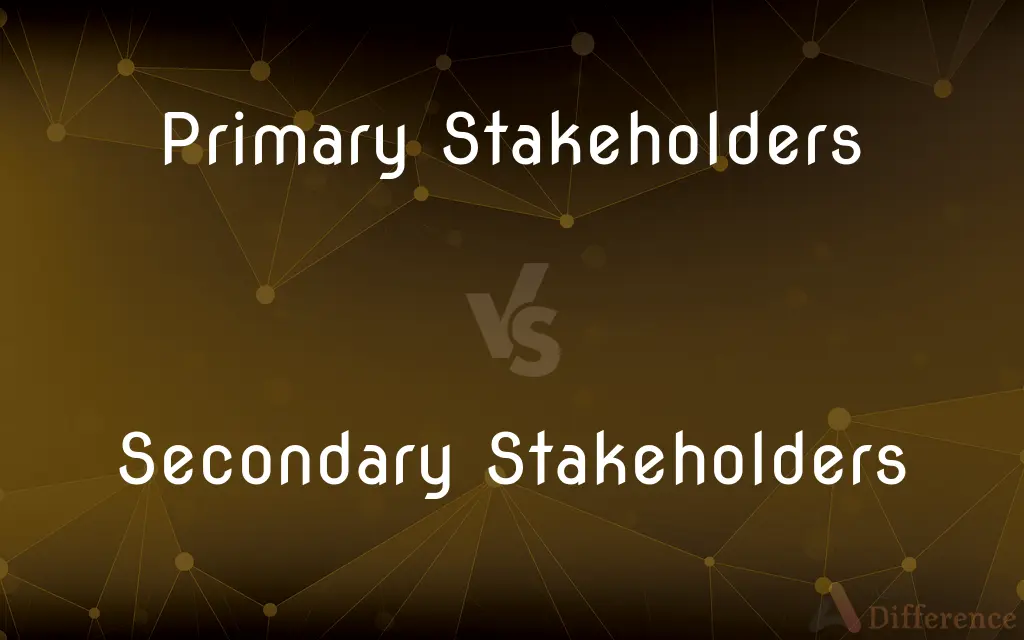Primary Stakeholders vs. Secondary Stakeholders — What's the Difference?
By Tayyaba Rehman — Published on October 11, 2023
Primary Stakeholders directly affect or are affected by an organization's actions, while Secondary Stakeholders have an indirect relationship or interest.

Difference Between Primary Stakeholders and Secondary Stakeholders
Table of Contents
ADVERTISEMENT
Key Differences
Primary Stakeholders have a direct connection, interest, or investment in a specific organization or project. Their well-being, rights, or financial state may be significantly influenced by the decisions made by the said organization. Secondary Stakeholders, conversely, don't have a direct stake but still show an interest in the organization or its projects, perhaps due to the ripple effects of its decisions.
In the corporate world, Primary Stakeholders usually include shareholders, employees, customers, and suppliers since they have a tangible stake in the company's performance. Secondary Stakeholders might consist of the local community, advocacy groups, or competitors, who, while influenced by the company's actions, don't engage with it directly in a transactional sense.
Primary Stakeholders often have a more immediate and pronounced impact on an organization's strategies and decisions due to their vested interests. The organization's success directly impacts their well-being. Secondary Stakeholders, while still influential, might exert their influence in more indirect ways, perhaps through public opinion or regulatory pressures.
While both Primary Stakeholders and Secondary Stakeholders play crucial roles in shaping an organization's direction, the former often has a more direct line of communication and influence. This is due to the immediate consequences they face from the organization's actions. Meanwhile, the latter group provides external perspectives and can highlight broader societal implications.
Comparison Chart
Directness of Relationship
Direct relationship with the organization.
Indirect or tertiary relationship.
ADVERTISEMENT
Impact on Organization
Immediate and pronounced impact.
Influence can be more indirect.
Examples
Shareholders, employees, suppliers.
Local community, advocacy groups, competitors
Influence Method
Direct communication, investment.
Public opinion, regulatory pressures.
Degree of Vested Interest
High vested interest and tangible stake.
Lesser vested interest, more distant effects.
Compare with Definitions
Primary Stakeholders
Those with a vital interest in an organization's success.
Shareholders, as Primary Stakeholders, are keenly interested in the company's profitability.
Secondary Stakeholders
Parties indirectly benefitting from a project's success.
Local businesses, being Secondary Stakeholders, benefit from increased tourism due to a new attraction.
Primary Stakeholders
Directly invested parties in a project's outcome.
Investors, as Primary Stakeholders, closely monitor the project's progress.
Secondary Stakeholders
Parties indirectly influenced by an organization.
The local community, as Secondary Stakeholders, felt the environmental effects of the factory.
Primary Stakeholders
Entities that bear direct consequences from a company's actions.
Suppliers, as Primary Stakeholders, rely on consistent business from the company.
Secondary Stakeholders
Those with a tertiary relationship to an organization.
Competitors, being Secondary Stakeholders, adjust their strategies based on market leaders.
Primary Stakeholders
Main entities influencing organizational decisions.
Customers, being Primary Stakeholders, heavily influence product developments.
Secondary Stakeholders
Entities without a direct stake but affected by organizational decisions.
Advocacy groups, as Secondary Stakeholders, often lobby for ethical business practices.
Primary Stakeholders
Direct participants in an organization's transactions.
Employees, as Primary Stakeholders, directly contribute to the company's operations.
Secondary Stakeholders
External entities interested in an organization's broader impact.
Government agencies, as Secondary Stakeholders, monitor compliance with regulations.
Common Curiosities
How do organizations cater to Primary Stakeholders?
By addressing their needs directly, through dividends, employee benefits, quality products, or consistent orders.
How do Primary Stakeholders influence business decisions?
Primary Stakeholders exert influence through investments, feedback, labor, or purchasing decisions.
Who are typically considered Primary Stakeholders?
Shareholders, employees, customers, and suppliers are common Primary Stakeholders.
Do Secondary Stakeholders have a financial stake in a company?
Not typically. Secondary Stakeholders have an interest or are affected, but they don't directly invest or transact.
Can competitors be Secondary Stakeholders?
Yes, competitors can be Secondary Stakeholders as they're affected by an organization's actions but don't have a direct relationship.
Share Your Discovery

Previous Comparison
Impolite vs. Polite
Next Comparison
Unit Banking vs. Branch BankingAuthor Spotlight
Written by
Tayyaba RehmanTayyaba Rehman is a distinguished writer, currently serving as a primary contributor to askdifference.com. As a researcher in semantics and etymology, Tayyaba's passion for the complexity of languages and their distinctions has found a perfect home on the platform. Tayyaba delves into the intricacies of language, distinguishing between commonly confused words and phrases, thereby providing clarity for readers worldwide.
















































